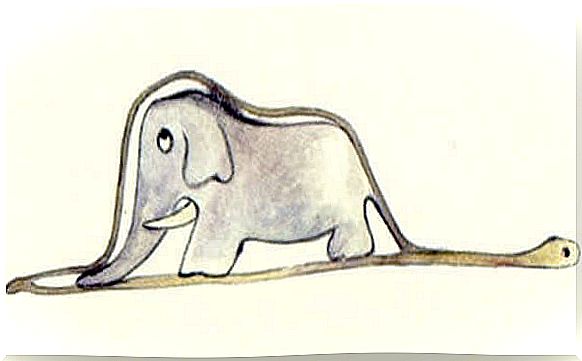Divergent Thinking: How Do You Develop It?

Divergent thinking, or lateral thinking, is about creating multiple creative solutions to the same problem. It is a spontaneous, non-linear, mental approach based on curiosity. In fact, it is a type of thinking that is very common in children, where joy, imagination and a fresh perspective make you reason more freely.
Divergent thinking is important in today’s modern world. In a society that is used to imitating similar skills, one comes to a point where large companies begin to appreciate other abilities. Other dimensions that bring creativity and vitality to their project. A person who can offer innovation and creativity can therefore become an attractive candidate.
However, our schools and universities still prioritize a very convergent type of thinking in their methodology. In the 1960s, JO Guilford defined convergent and divergent thinking.
Even when Guilford emphasized the importance of training children in divergent thinking, educational institutions have not paid attention to this. They have prioritized a type of reflection (or rather lack) where the student must use linear thinking, rules and structured processes to find the “right” solution.
This strategy is often useful and necessary, but real life is complex and dynamic and it is unrealistic to believe that problems have only one solution. We should therefore learn how to use really divergent thinking.
Many training centers encourage their students to do more than find the right answer. The goal is to be able to create new questions.

Before we continue, it would have been good to clarify one thing. There is no one way of thinking that is better than another. Convergent thinking is useful and necessary on many occasions. The real problem, however, is that we have been “trained” to think only in this way. We have put spontaneity and creativity aside.
In many of the courses where the students were trained in divergent thinking, they had to answer the following types of questions:
- What can you do for things with a brick and a pencil? What uses can you come up with if we gave you a toothbrush and a toothpick?
In the beginning, it can be difficult to come up with something. However, some people may come up with multiple answers and creative ideas because they are good at what Edward de Bono calls “lateral thinking”. To understand a little better how this works, we will now look at the psychological processes that arise.

Semantic networks
Divergent thinking is the ability to find relationships between ideas, concepts and processes that at first glance seem to be very different. Psychologists who are experts in creativity believe that people have different mental association networks:
- People with “deep” semantic networks are more guided by logic and linear thinking.
- People with “flat” semantic networks have mental networks that are much more connected. In other words, they sometimes relate two things to each other that do not seem to be true, but other networks contribute and the result is an ingenious idea.
The right and the left brain
We have all heard about how the right half of the brain is the creative side and that the left is the logical one. According to this theory, those who use divergent or lateral thinking will use more of the right hemisphere. We must be careful with this type of generalization concerning cerebral dominance, because it is really a very nuanced process.
We cannot see the brain as an entity with clearly separated areas. In fact, when we create an idea, whether it is ingenious, conservative, logical or very creative, we use the whole brain. The trick is to know how to connect one idea to another. The most ingenious people use tree-like thought processes. In other words, they create connections on both sides of the brain, not just one of them.

As I said before, all of us, regardless of age, can practice and improve divergent thinking. To do this, we will focus on four areas:
- Flow: the ability to produce a large number of ideas.
- Flexibility: the ability to create a wide variety of ideas based on different fields of knowledge.
- Originality: the ability to create innovative ideas.
- Development: the ability to improve our ideas to make them more sophisticated.
Here are four ways to improve the above areas:
Synectic exercises
“Synectics” is a term coined by psychologist William JJ Gordon. It is about finding connections and relationships between concepts, objects and ideas that seem to be unrelated. This exercise takes a lot of mental work. We can do it daily by choosing the concepts ourselves. For example:
- What can I do with a clamp and a spoon?
- What is the relationship between the Limpopo River in Africa and Lake Baikal in Siberia?
Shot technique
The Skutt Technician is another creative idea development strategy developed by Bob Eberle. It is very useful for creating something innovative and for training in divergent thinking. Let us say, for example, that we have come up with an idea within the work. Since we have that “idea”, we will run it through a number of “filters”.
- Replace one element of that idea with another. (What can we change about how we have fun? And how we work?)
- Now combine everything. (What can people do to be less stressed in other workplaces?)
- Modify it (How can we work without getting stressed?)
- Give it to others (What is it at work that I can do in a more fun way?)
- Delete something (What if you went to work a little earlier and used the day better?)
- Reform it (What would have happened if I dared…?)

Psychologist Nina Lieberman’s research in the very interesting book Playfulness: Its Relatonship to Imagination and Creativity has something very relevant to contribute to this discussion. Divergent thinking goes hand in hand with joy, optimism and inner well-being. Having good relationships, being rested and not feeling pressured or having anxiety and stress opens the way for your divergent thinking.
We live very active lives, and we envy these valuable dimensions there. We can thus also state that this type of thinking arises when you have a certain attitude towards life: free, happy, and open to new experiences…








